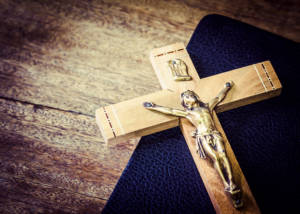
During Lent, religious artifacts, such as this crucifix, will be covered for the entire duration of the fast.
One common thread between most Christian religions is the celebration of the resurrection of Christ, or Easter. The weeks leading up to Easter are often used as a time of remembrance of Christ’s ministry and what he went through before his death. In Christianity, the season of Lent is the 40 days before Easter. Because the date of Easter is based on a lunar, rather than solar, calendar, the beginning of Lent changes each year. Traditionally, the first day of Lent is called Ash Wednesday, which in 2017 falls on March 1.
Traditions of Lent
On Ash Wednesday, Christians attend a worship service in which the minister or priest makes the sign of a cross with ashes on the forehead of the worshipper. This symbolizes the sinfulness before God and human mortality. In the Bible, in both Hebrews and Numbers, the ashes of a red heifer would sanctify the ceremonially unclean. Ashes were thought to be purifying.
Human sorrow is represented by ashes. In the book of Esther, the Jews “lay in sackcloth and ashes” as a way of mourning the edict of the King that allowed for the destruction of the Jews. Job used dust and ashes as a symbol of repentance.
Fasting is one of the most common ways that Lent is observed. In older times, the tradition would be to have one full meal per day, with smaller meals allowed. The idea was that a person should have enough food to sustain strength, but never enough to feel full. Each community would have their own traditions, but generally, animal products were forbidden. Fish and fowl might be allowed on Fridays.
On Sundays, the fast would be suspended, but during Lent, Christians would refrain from saying “Alleluia” or the “Gloria in excelsis Deo” rite. These rituals were associated with joy. Because Lent was a time of sorrow, the words would be replaced with another phrase or simply omitted during the season.
During Lent the religious objects such as the cross, statues and pictures might be veiled for the entire 40 days. However, Anglican and Methodist churches traditionally only cover the objects on Good Friday. In more progressive churches, the liturgy of Lent might not be observed at all. Instead, the emphasis is on Easter Sunday, rather than penitence.
Fasting for Social Change
One current trend seen around Lent is that of a positive fast. People don’t just give up food or pleasure, but instead contribute to environmental stewardship. At Greenanglicans.org, people are remembering the 40 days that Jesus spent in the wilderness by doing one thing every day to be more environmentally conscious. For example, have dinner by candlelight and then talk and play games together.
Charisma House, a Christian publisher, is suggesting a 10-day word fast from complaining, criticism, sarcasm and gossip. According to Isaiah 58:6: “Is not this the kind of fasting I have chosen: to loose the chains of injustice and untie the cords of the yoke, to set the oppressed free and break every yoke?” The study asks you to watch what you say for just 10 days, to help you change a pattern of discouragement and negativity.
Another interesting concept is taking on atheism for Lent. For 40 days, a Christian examines literature that speaks to who God is and his or her beliefs in God. It’s a time to examine ideological structures of religion.
You do not have to honor Lent to celebrate Easter, but respect those who do. It’s a Christian tradition that means a lot to those who do partake in the season.


